Yokosuka: 7 Places to Visit in the Vibrant Port City Near Tokyo

Yokosuka is a port city reachable in less than one hour by train from Tokyo. This city has played a major role in Japan's maritime history. We introduce seven places to visit in Yokosuka, including Dobuita Street, a famous curry restaurant, a local shrine, Kurihama Flower Park, and more!
Yokosuka: Enjoy a Fun-Filled Day Trip by the Ocean
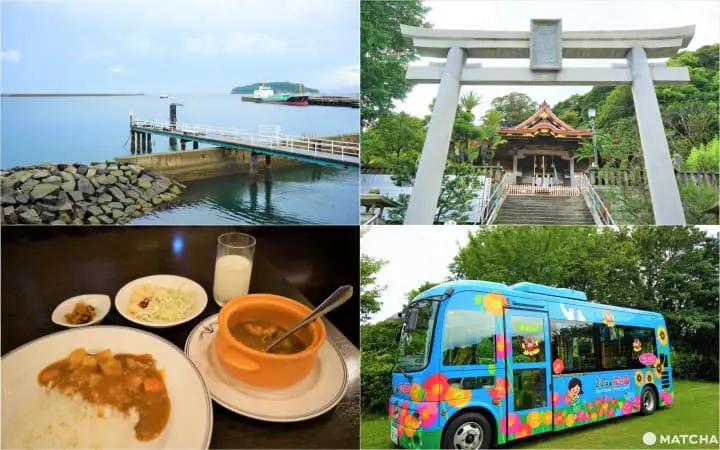
Yokosuka is a port city in Kanagawa, just about 45 minutes by train from Tokyo's Shinagawa Station. Surrounded on three sides by the ocean, this city has played a major role in Japan's maritime history.
Yokosuka's Uraga Harbor was where the ships of the expedition for the opening of Japan led by Commodore Perry landed in 1853, marking the beginning of Japan's trade relations with the West.
Yokosuka has thrived as a port city in the modern age and is still a city of seafarers, with an open, international atmosphere. Spend a day in Yokosuka and you'll get to experience local cultures born out of the closeness to the sea, stunning views of the ocean and the nearby islands, as well as glimpses of naval history in Japan.
Things to Do in Yokosuka
1. Dobuita Street
2. Mikasa Park
3. Yokosuka Navy Curry Honpo
4. Seieiken: Japanese Sweets
5. Kano Jinja Shrine
6. Kurihama Flower Park
7. Kannonzaki Park
Travel Hack: Use the Yokosuka Mankitsu Kippu Discount Ticket
1. Dobuita Street: Local Fashion, Food, and Bars
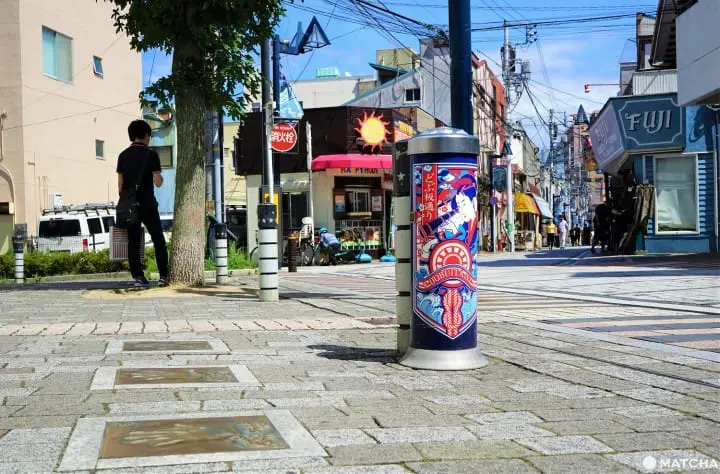
Dobuita Street is the place where you'll find a unique mix of Japanese and American culture. Located close to the U.S. military base, this street is lined with shops, cafes, and bars frequented by both American and Japanese sailors.
Many of the fashion shops here sell vintage clothes and military-themed apparel. Dobuita Street is where you can get the iconic fashion item of the city: the sporty, flashy Yokosuka jacket, called "Sukajan", made with local embroidery. This type of jacket embodies the free spirit of Yokosuka, where different cultures intermingle and coexist.
During the day, you can taste regional specialties like Yokosuka Navy Burgers and Yokosuka Navy Curry at the restaurants and cafes lining the street. The area gets especially lively at night when the bars open for business.
Hotels near Dobuita Street
↑ Return to the top of article.
2. Mikasa Park: Ocean Views and Japanese Naval History

Mikasa Park is located by the ocean offering great views of Sarushima, the deserted island off the shore of Yokosuka. Here, you can enjoy views of the ocean at leisure while surrounded by the lush greenery of the park.
Memorial Ship Mikasa, a battleship that was used in the 1905 Russo-Japanese War, is stationed here. It is now a museum showcasing Japan's international maritime history.
Hotels near Mikasa Park
↑ Return to the top of article.
3. Yokosuka Navy Curry Honpo: Taste Some of the Best Curry in Town!

Yokosuka Navy Curry Honpo, located just 3 minutes on foot from Yokosuka Chuo Station, is a shop and restaurant specializing in Yokosuka Navy Curry, the widely acclaimed local dish.
The shop, selling various types of Yokosuka Curry, as well as snacks and souvenirs, is located on the first floor. The restaurant occupies the second floor.

You can recognize the store by its cute sailor mascot stationed at the entrance.
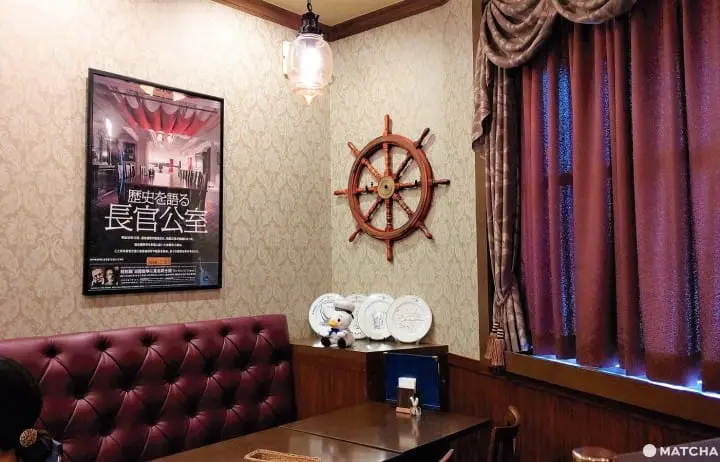
The ship-themed interior has a subdued elegance. It brings up images of days spent in austerity on board a ship that takes months to cross to ocean.

We tried the Yokosuka Kaigun Curry Special (1,380 yen) set meal. It consists of Navy curry sauce (made with chicken or beef) and rice, salad, a glass of milk, and a drink (coffee or tea).
The curry sauce at Yokosuka Navy Curry Honpo is based on a recipe from around 1910. This was when the Japanese Navy introduced Western dishes in the diet of Navy soldiers to improve their health and strength through better nutrition. Curry sauce, adapted to the Japanese palate by mixing in vegetables and meat, was praised for its nutritional value. It eventually became the signature local dish of Yokosuka Port.
After trying it ourselves, all we can say is that this might just be the smoothest, tastiest curry you'll find in Japan!
↑ Return to the top of article.
4. Seieiken: Refined Japanese Confectionery
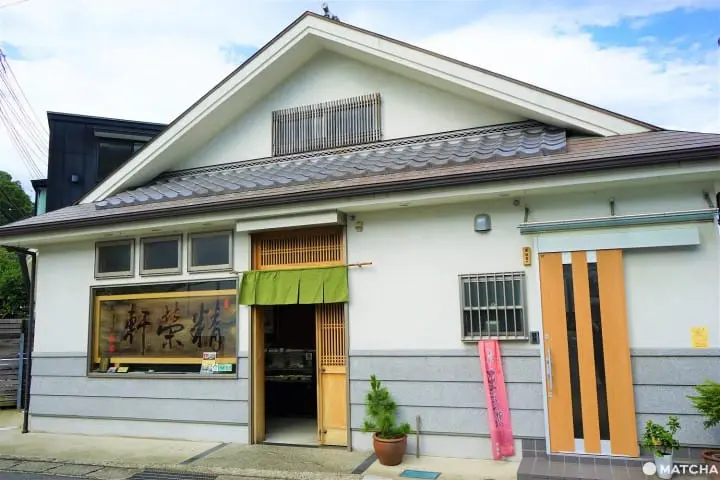
Seieiken is a Japanese confectionery shop located in the town of Uraga. They have been producing Japanese sweets for decades now.
The logo of this well-established store is inspired by the "black ships" led by Commodore Perry that reached Uraga Harbor in 1953, changing the course of Japanese history. The store is located right by Uraga Bay.

Seieiken produces various types of wagashi (Japanese sweets) using traditional basic ingredients like anko (red bean paste), rice flour, and brown sugar, but also snacks of Western inspiration such as castella.
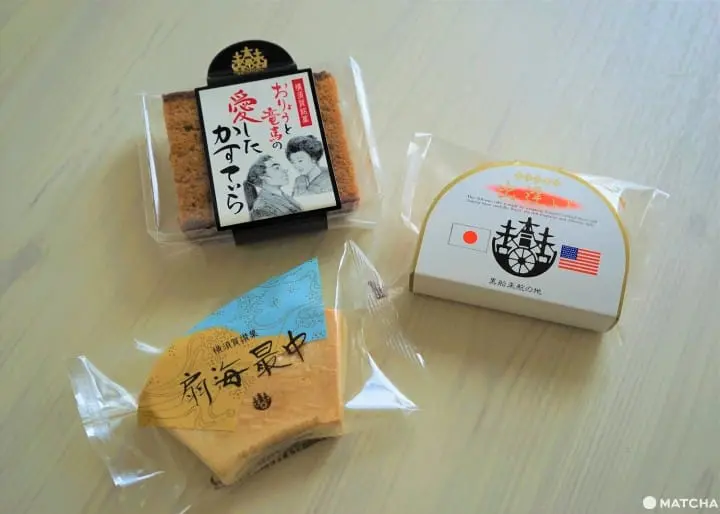
The confectionery that the shop takes pride in is the Senkai Monaka, a fan-shaped cookie filled with sweet red bean paste. Its shape takes inspiration from Uraga Bay, which spreads like a fan toward the ocean.
Another popular choice is Deai, a castella cake with ume plum filling, which reflects the encounter between Eastern and Western cultures. While ume is a typical Japanese flavor, the castella, originating in Portugal, represents a taste and texture from the West. The brown sugar castella cake is their latest release.
You'll notice the distinctive store logo on all of their products, hinting at the international history of Uraga Bay.
↑ Return to the top of article.
5. Kano Jinja: Visit Beautiful Twin Shrines

Right across the street from Seieiken in Uraga is Nishi Kano Jinja, a majestic shrine dedicated to the guardian deity of western Uraga.
The name of the shrine, Kano, come from "kanau," which means "to fulfill" in Japanese. This is because the deity enshrined here is believed to answer prayers that come from the heart.
This shrine has a twin on the other side of Uraga Bay called Higashi Kano Jinja.

To visit the Higashi Kano Jinja, take the red boat stationed close-by in the harbor. A ride costs 200 yen. The boat departs whenever there's a customer.
It is said that if you buy a talisman from Nishi Kano Jinja and wrap it up in a small talisman bag from the Higashi Kano Jinja, your deepest wish will come true.
↑ Return to the top of article.
6. Kurihama Flower Park: A Flower Paradise in All Seasons!

Kurihama Flower Park is an extensive park with beautiful flower displays all throughout the year. Offering splendid views of the ocean and plenty of playgrounds, this park is an ideal destination if you travel with children or if you just want to unwind in the heart of nature.
The park has a few restaurants and cafes where you can rest and reenergize with local specialties.

Kurihama Flower Park is famous for its cosmos flowers that bloom in wonderful pink hues in the fall. We visited at the end of summer, when the orange cosmos flowers were in bloom.
↑ Return to the top of article.
7. Kannonzaki Park: Visit the Lighthouse and an Excellent Art Museum

Kannonzaki Park is located by the coast, offering great views of Tokyo Bay. You can walk along the shore and feel the gentle waves splashing at your feet.
The photogenic Kannonzaki Lighthouse is a great place to visit at any time of the day.
The Yokosuka Museum of Art is also located on this coast, surrounded by the lush greenery of Kannonzaki Park. The museum boasts a collection of over 5,000 works by modern and Japanese artists.
The building itself is a remarkable piece of architecture, employing natural light and the scenic ocean view. It's an excellent place to spend a relaxing afternoon by the ocean.
Hotels near Kanagawa Prefectural Kannonzaki Park
Travel Hack: Use the Yokosuka Mankitsu Kippu Discount Ticket

The Yokosuka Mankitsu Kippu is a discount day-trip ticket issued by Keikyu Railway. Priced at 3,110 yen, it includes unlimited train and bus rides from Shinagawa Station to and within Yokosuka using the Keikyu lines (ticket A), as well as a meal ticket (ticket B) and a souvenir ticket (ticket C). The latter two can be exchanged for a meal and goods at any of the participating facilities.
This is definitely the most cost-efficient way to enjoy a trip to Yokosuka! Purchase this ticket at any Keikyu ticket office in Shinagawa Station.
Here's an itinerary example using the Yokosuka Mankitsu Kippu:
Depart from Shinagawa Station before 9:00 (ticket A) and get off at Yokosuka Chuo Station → Dobuita Street → Mikasa Park → Have lunch at Yokosuka Navy Curry Honpo (use ticket B) → travel to Uraga Station (ticket A) → exchange ticket C for sweets at Seieiken → visit Nishi Kano Jinja → head to either Kurihama Flower Park or Kannonzaki Park for a relaxing afternoon (by bus, using ticket A).
When boarding a Keikyu bus, you'll just have to show ticket A to the driver. All the participating facilities will recognize the Yokosuka Mankitsu Kippu and accept these tickets as payment.
The ocean views, the history of the city, and the vibrant, youthful atmosphere of Yokosuka will no doubt fill you with positive energy. Do enjoy a day trip to this beautiful city by the ocean!
FAQ
Is Yokosuka worth visiting?
Yokosuka offers a blend of history, culture, nature, and unique experiences that can make it a worthwhile destination for a visit. Whether you're interested in naval history, art, or just want to explore a different side of Japan, Yokosuka has something to offer. Visit the Mikasa Park for naval history, the Yokosuka Museum of Art for contemporary art, Dobuita Street for fashion shopping, dining, and bars, and the Kurihama Flower Park for natural scenery. If any of these aspects pique your interest, then Yokosuka could definitely be worth a visit.
What is Yokosuka known for?
Yokosuka, Japan, is renowned for the Yokosuka Naval Base, hosting the U.S. Navy's Seventh Fleet. The city's maritime legacy extends to shipbuilding and nautical culture, evident in museums and historical sites. Yokosuka's international flair arises from its diverse populace, including Americans from the naval base, fostering a blend of Japanese and Western influences. Tourists appreciate scenic views along Tokyo Bay, unique Yokosuka curry, and varied local cuisine. Festivals like the Yokosuka Curry Festival highlight the city's cultural richness and historical ties. Yokosuka's reputation is rooted in naval history, cultural exchange, waterfront beauty, and gastronomic delights, making it a compelling destination embodying Japan's maritime heritage and international connections.
What food is Yokosuka known for?
Yokosuka is best known for its unique style of curry, often referred to as "Navy Curry" or "Yokosuka Curry." This curry has a distinct history linked to the influence of the U.S. Navy presence in the area. Yokosuka curry typically features a thick, sweet, and mildly spicy sauce served over rice, often accompanied by toppings like fried pork cutlets (tonkatsu) or seafood. In addition to curry, Yokosuka offers a variety of delicious seafood dishes due to its coastal location. Being a port city, fresh seafood such as sashimi, grilled fish, and seafood bowls are popular choices among locals and visitors alike. Furthermore, Yokosuka's culinary scene reflects its international connections, with a range of dining options including American-style restaurants, fusion cuisines, and traditional Japanese eateries.
How to travel to Yokosuka from Tokyo?
To travel from Tokyo to Yokosuka, take the JR Yokosuka Line from Tokyo Station directly to Yokosuka Station, a journey lasting about 1.5 to 2 hours. Alternatively, consider the JR Shonan-Shinjuku Line from Shinjuku Station. Highway buses are available but slower, offering an affordable option. You can also take a Keikyu Line train from Shinagawa Station. The Keikyu Line offers a special day-trip ticket for Yokosuka called "Yokosuka Mankitsu Kippu," which covers the roundtrip ticket to and from Yokosuka, bus transportation on Keikyu buses within Yokosuka, a lunch ticket at a participating restaurant, and a souvenir voucher.
When is the best time to visit Yokosuka?
Yokosuka is a great day trip destination from Tokyo at any time of the year. However, is you loo forward to beautiful ocean views and the natural scenery at Kurihama Flower Park, visiting in spring, summer, or autumn would be a great choice.
Ramona, English content editor at MATCHA since 2016, has been practicing ikebana flower arrangement (Ikenobo School) and tea ceremony (Omote Senke) since 2012. She arrived in Japan in 2012 as a graduate student with a focus on Japanese literature and performing arts. As a travel editor and writer, Ramona has visited and documented 40 of Japan's prefectures with a focus on art, history, traditional Japanese crafts, and performing arts.



















































![[2026] Top 5 Strawberry Picking Spots in Tokushima, Naruto| Farms and Access Guide for January to May](https://resources.matcha-jp.com/resize/720x2000/2025/03/06-227165.webp)
![[Yamanashi/ Hokuto City] 4 Hot New Spots Opening in 2026](https://resources.matcha-jp.com/resize/720x2000/2025/12/12-252747.webp)


